Scrapy框架
第一板块:scrapy介绍、安装、基本使用
-什么是框架?
-就是一个集成了很多功能并且具有很强通用性的一个项目模板。
-如何学习框架?
-专门学习框架封装的各种功能的详细用法。
-什么是scrapy?
-爬虫中封装好的一个明星框架。功能:高性能的持久化操作,异步的数据下载,高性能的数据解析,分布式。
-scrapy框架的基本使用
-环境的安装:
-mac or linux: pip install scrapy
-windows:
-下载twisted,下载地址为:
http://www.lfd.uci.edu/~gohlke/pythonlibs/#twisted
-安装twisted:
pip install Twisted-17.1.0-cp36-cp36m-win_amd64.whl
-pip install pywin32
-pip install scrapy
测试:在终端里录入scrapy指令,没有报错即表示安装成功!
-创建一个工程:scrapy startproject xxxPro
-cd xxxPro
-在spiders子目录中创建一个爬虫文件
-scrapy genspider spiderName www.xxx.com
-执行工程:
-scrapy crawl spiderName
scrapy的配置文件修改:

运行结果如下:
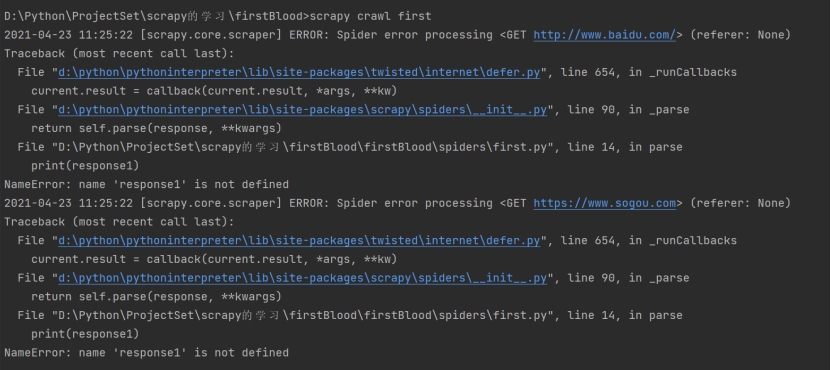
在spiders文件夹中创建一个基于scrapy框架的爬虫文件后,对配置文件必要的设置如下:(UA伪装)

第二大板块:基于scrapy的数据解析
-创建一个scrapy工程的基本目录结构如下:
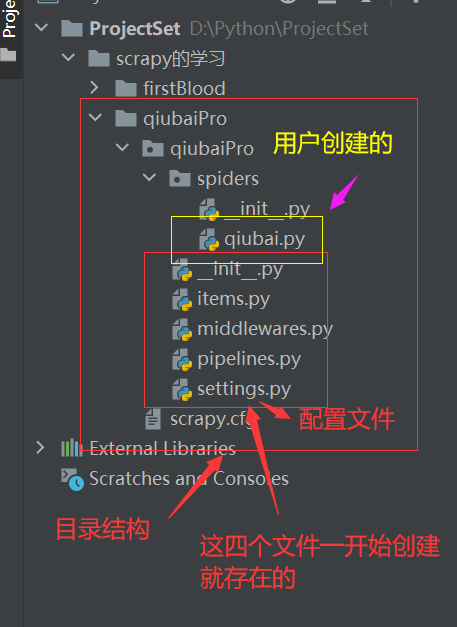
qiubai.py
1 import scrapy 2 3 4 class QiubaiSpider(scrapy.Spider): 5 name = 'qiubai' 6 # allowed_domains = ['www.xxx.com'] 7 start_urls = ['https://www.qiushibaike.com/text/'] 8 9 def parse(self, response): 10 #解析:作者的名称+段子的内容 11 div_list = response.xpath('//div[@class="col1 old-style-col1"]/div') 12 # print(len(div_list)) 13 num = 0 14 for div in div_list: 15 #xpath 返回的是列表,但是列表元素一定是Selector类型的对象 16 #extract可以将Selector对象中data参数存储的字符串提取出来 17 author = div.xpath('./div[1]/a[2]/h2/text()')[0].extract() 18 #列表调用了extract之后,则表示将列表中每一个Selector对象中data对应的字符串提取了出来 19 content = div.xpath('./a[1]/div/span//text()').extract() 20 #将列表转化成字符串 21 content = ''.join(content) 22 print("++++++++++++++++++++++++++++++++++++") 23 print(num,author,content) 24 print("++++++++++++++++++++++++++++++++++++") 25 num+=1
注意:
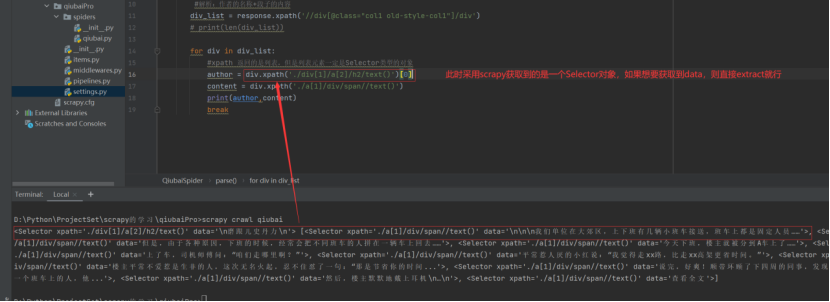
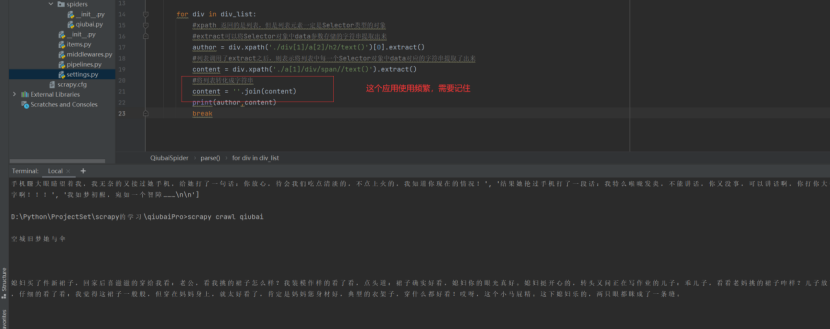
-etract_first()操作前提条件是得保证是对列表长度为1的进行操作。
总结:
UA伪装、Robot协议、日志文件的设置都在settings.py即配置文件中;
规定在spiders子目录下创建scrapy爬虫;
项目运行方式为:scrapy crawl spiderName;
对于scrapy爬虫得到的response对象,进行xpath操作后,得到的对象不是一个etree对象而是一个Selector对象,那么要取得其data数据则只需将Selecor对象进行extract操作就行;
第三大板块:scrapy持久化存储
-基于终端指令:(比较小众,用得很少)
-要求:只可以将parse方法的返回值存储到本地的文本文件中
-注意:持久化存储对应的文本文件的类型只可以为:
'json', 'jsonlines', 'jl', 'csv', 'xml', 'marshal', 'pickle'
-指令:scrapy crawl xxx -o filePath
-好处:简洁高效便捷
-缺点:局限性比较强(数据只可以存储到指定后缀的文本文件中)
qiubai.py
1 import scrapy 2 3 4 class QiubaiSpider(scrapy.Spider): 5 name = 'qiubai' 6 # allowed_domains = ['www.xxx.com'] 7 start_urls = ['https://www.qiushibaike.com/text/'] 8 9 def parse(self, response): 10 #解析:作者的名称+段子的内容 11 div_list = response.xpath('//div[@class="col1 old-style-col1"]/div') 12 # print(len(div_list)) 13 all_data = [] #存储所有解析到的数据 14 for div in div_list: 15 #xpath 返回的是列表,但是列表元素一定是Selector类型的对象 16 #extract可以将Selector对象中data参数存储的字符串提取出来 17 author = div.xpath('./div[1]/a[2]/h2/text()')[0].extract() 18 #列表调用了extract之后,则表示将列表中每一个Selector对象中data对应的字符串提取了出来 19 content = div.xpath('./a[1]/div/span//text()').extract() 20 #将列表转化成字符串 21 content = ''.join(content) 22 dic = { 23 'author':author, 24 'content':content 25 } 26 all_data.append(dic) 27 28 return all_data
运行结果如下:
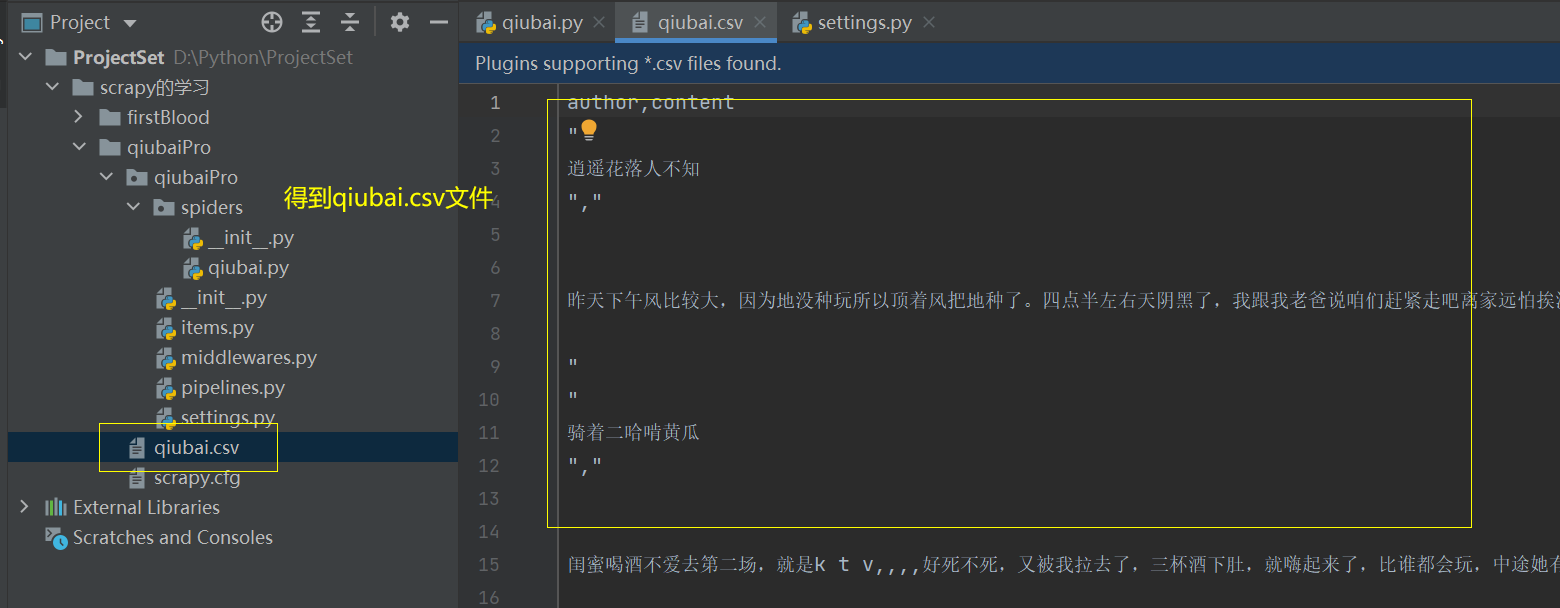
-基于管道:
-编码流程:
-数据解析
-在item类中定义相关的属性 item.py
-将解析的数据封装存储到item类型的对象
-将item类型的对象提交给管道进行持久化存储的操作
-在管道类的process_item中要将其接受到的item对象中存储的数据进行持久化存储操作 piplines.py
-在配置文件中开启管道

-好处:
-通用性强。
为什么要创建item对象呢?因为基于管道实现永久化存储方式是利用了process_items方法

于是就要将解析后的数据放到item对象中,再将item对象提交给管道进行存储


-面试题:将爬取到的数据一份存储到本地一份存储到数据库,如何实现?
-管道文件中一个管道类对应的是将数据存储到一种平台
-爬虫文件提交的item只会给管道文件中第一个被执行的管道类接收
-process_item中的return item表示将item传递给下一个即将被执行的管道类
qiubai.py代码如下:
1 import scrapy 2 from qiubaiPro.items import QiubaiproItem 3 4 class QiubaiSpider(scrapy.Spider): 5 name = 'qiubai' 6 # allowed_domains = ['www.xxx.com'] 7 start_urls = ['https://www.qiushibaike.com/text/'] 8 9 # def parse(self, response): 10 # #解析:作者的名称+段子的内容 11 # div_list = response.xpath('//div[@class="col1 old-style-col1"]/div') 12 # # print(len(div_list)) 13 # all_data = [] #存储所有解析到的数据 14 # for div in div_list: 15 # #xpath 返回的是列表,但是列表元素一定是Selector类型的对象 16 # #extract可以将Selector对象中data参数存储的字符串提取出来 17 # author = div.xpath('./div[1]/a[2]/h2/text()')[0].extract() 18 # #列表调用了extract之后,则表示将列表中每一个Selector对象中data对应的字符串提取了出来 19 # content = div.xpath('./a[1]/div/span//text()').extract() 20 # #将列表转化成字符串 21 # content = ''.join(content) 22 # dic = { 23 # 'author':author, 24 # 'content':content 25 # } 26 # all_data.append(dic) 27 # 28 # return all_data 29 def parse(self, response): 30 # 解析:作者的名称+段子的内容 31 div_list = response.xpath('//div[@class="col1 old-style-col1"]/div') 32 # print(len(div_list)) 33 all_data = [] # 存储所有解析到的数据 34 for div in div_list: 35 # xpath 返回的是列表,但是列表元素一定是Selector类型的对象 36 # extract可以将Selector对象中data参数存储的字符串提取出来 37 author = div.xpath('./div[1]/a[2]/h2/text() | ./div[1]/span/h2/text()')[0].extract() 38 # 列表调用了extract之后,则表示将列表中每一个Selector对象中data对应的字符串提取了出来 39 content = div.xpath('./a[1]/div/span//text()').extract() 40 # 将列表转化成字符串 41 content = ''.join(content) 42 43 item = QiubaiproItem() 44 item['author'] = author 45 item['content'] = content 46 47 yield item #将item提交给了管道
pipelines.py
1 # Define your item pipelines here 2 # 3 # Don't forget to add your pipeline to the ITEM_PIPELINES setting 4 # See: https://docs.scrapy.org/en/latest/topics/item-pipeline.html 5 6 7 # useful for handling different item types with a single interface 8 from itemadapter import ItemAdapter 9 10 import pymysql 11 12 class QiubaiproPipeline: 13 fp = None 14 #重写父类方法:该方法只在开始爬虫的时候被调用一次 15 def open_spider(self,spider): 16 print('开始爬虫...') 17 self.fp = open('./qiubai.txt','w',encoding='utf8') 18 19 #专门用来处理item类型的对象 20 #该方法可以接收爬虫文件提交过来的item对象 21 #该方法每接收到一个item就会被调用一次 22 def process_item(self, item, spider): 23 author = item['author'] 24 content = item['content'] 25 self.fp.write(author+':'+content+'\n') 26 27 return item #就会传递给下一个即将被执行的管道类,所以一定要加上return item 28 29 def close_spider(self,spider): 30 print('结束爬虫...') 31 self.fp.close() 32 33 #管道文件中一个管道类对应将一组数据存储到一个平台或者载体中 34 class mysqlPileLine(object): 35 36 conn = None 37 cursor = None 38 def open_spider(self,spider): 39 self.conn = pymysql.Connect(host='127.0.0.1',port=3306,user='root',password='123456',db='qiubai',charset='utf8') 40 41 def process_item(self,item,spider): 42 self.cursor = self.conn.cursor() 43 44 try: 45 46 self.cursor.execute('insert into qiubai values("%s","%s")'%(item["author"],item["content"])) 47 self.conn.commit() #事务的提交 48 except Exception as e: 49 print(e) 50 self.conn.rollback() #事务的回滚 51 52 return item 53 54 def close_spider(self,spider): 55 self.cursor.close() 56 self.conn.close() 57 58 59 #爬虫文件提交的item类型的对象最终会提交给哪一个管道类? 60 #先执行优先级最高的管道类
settings.py
1 # Scrapy settings for qiubaiPro project 2 # 3 # For simplicity, this file contains only settings considered important or 4 # commonly used. You can find more settings consulting the documentation: 5 # 6 # https://docs.scrapy.org/en/latest/topics/settings.html 7 # https://docs.scrapy.org/en/latest/topics/downloader-middleware.html 8 # https://docs.scrapy.org/en/latest/topics/spider-middleware.html 9 10 BOT_NAME = 'qiubaiPro' 11 12 SPIDER_MODULES = ['qiubaiPro.spiders'] 13 NEWSPIDER_MODULE = 'qiubaiPro.spiders' 14 15 16 # Crawl responsibly by identifying yourself (and your website) on the user-agent 17 USER_AGENT = 'Mozilla/5.0 (Windows NT 10.0; Win64; x64) AppleWebKit/537.36 (KHTML, like Gecko) Chrome/90.0.4430.85 Safari/537.36' 18 19 # Obey robots.txt rules 20 ROBOTSTXT_OBEY = False 21 22 LOG_LEVEL = 'ERROR' 23 24 # Configure maximum concurrent requests performed by Scrapy (default: 16) 25 #CONCURRENT_REQUESTS = 32 26 27 # Configure a delay for requests for the same website (default: 0) 28 # See https://docs.scrapy.org/en/latest/topics/settings.html#download-delay 29 # See also autothrottle settings and docs 30 #DOWNLOAD_DELAY = 3 31 # The download delay setting will honor only one of: 32 #CONCURRENT_REQUESTS_PER_DOMAIN = 16 33 #CONCURRENT_REQUESTS_PER_IP = 16 34 35 # Disable cookies (enabled by default) 36 #COOKIES_ENABLED = False 37 38 # Disable Telnet Console (enabled by default) 39 #TELNETCONSOLE_ENABLED = False 40 41 # Override the default request headers: 42 #DEFAULT_REQUEST_HEADERS = { 43 # 'Accept': 'text/html,application/xhtml+xml,application/xml;q=0.9,*/*;q=0.8', 44 # 'Accept-Language': 'en', 45 #} 46 47 # Enable or disable spider middlewares 48 # See https://docs.scrapy.org/en/latest/topics/spider-middleware.html 49 #SPIDER_MIDDLEWARES = { 50 # 'qiubaiPro.middlewares.QiubaiproSpiderMiddleware': 543, 51 #} 52 53 # Enable or disable downloader middlewares 54 # See https://docs.scrapy.org/en/latest/topics/downloader-middleware.html 55 #DOWNLOADER_MIDDLEWARES = { 56 # 'qiubaiPro.middlewares.QiubaiproDownloaderMiddleware': 543, 57 #} 58 59 # Enable or disable extensions 60 # See https://docs.scrapy.org/en/latest/topics/extensions.html 61 #EXTENSIONS = { 62 # 'scrapy.extensions.telnet.TelnetConsole': None, 63 #} 64 65 # Configure item pipelines 66 # See https://docs.scrapy.org/en/latest/topics/item-pipeline.html 67 ITEM_PIPELINES = { 68 'qiubaiPro.pipelines.QiubaiproPipeline': 300, 69 'qiubaiPro.pipelines.mysqlPileLine': 301, 70 #300表示的是优先级,数值越小优先级越高 71 } 72 73 # Enable and configure the AutoThrottle extension (disabled by default) 74 # See https://docs.scrapy.org/en/latest/topics/autothrottle.html 75 #AUTOTHROTTLE_ENABLED = True 76 # The initial download delay 77 #AUTOTHROTTLE_START_DELAY = 5 78 # The maximum download delay to be set in case of high latencies 79 #AUTOTHROTTLE_MAX_DELAY = 60 80 # The average number of requests Scrapy should be sending in parallel to 81 # each remote server 82 #AUTOTHROTTLE_TARGET_CONCURRENCY = 1.0 83 # Enable showing throttling stats for every response received: 84 #AUTOTHROTTLE_DEBUG = False 85 86 # Enable and configure HTTP caching (disabled by default) 87 # See https://docs.scrapy.org/en/latest/topics/downloader-middleware.html#httpcache-middleware-settings 88 #HTTPCACHE_ENABLED = True 89 #HTTPCACHE_EXPIRATION_SECS = 0 90 #HTTPCACHE_DIR = 'httpcache' 91 #HTTPCACHE_IGNORE_HTTP_CODES = [] 92 #HTTPCACHE_STORAGE = 'scrapy.extensions.httpcache.FilesystemCacheStorage'
items.py
1 # Define here the models for your scraped items 2 # 3 # See documentation in: 4 # https://docs.scrapy.org/en/latest/topics/items.html 5 6 import scrapy 7 8 9 class QiubaiproItem(scrapy.Item): 10 # define the fields for your item here like: 11 # name = scrapy.Field() 12 author = scrapy.Field() 13 content = scrapy.Field()



